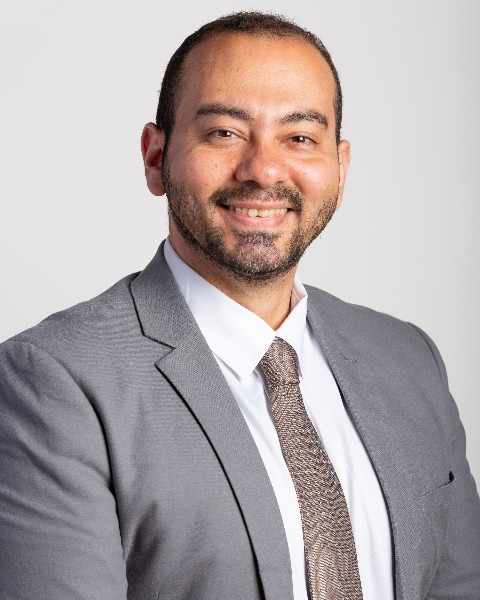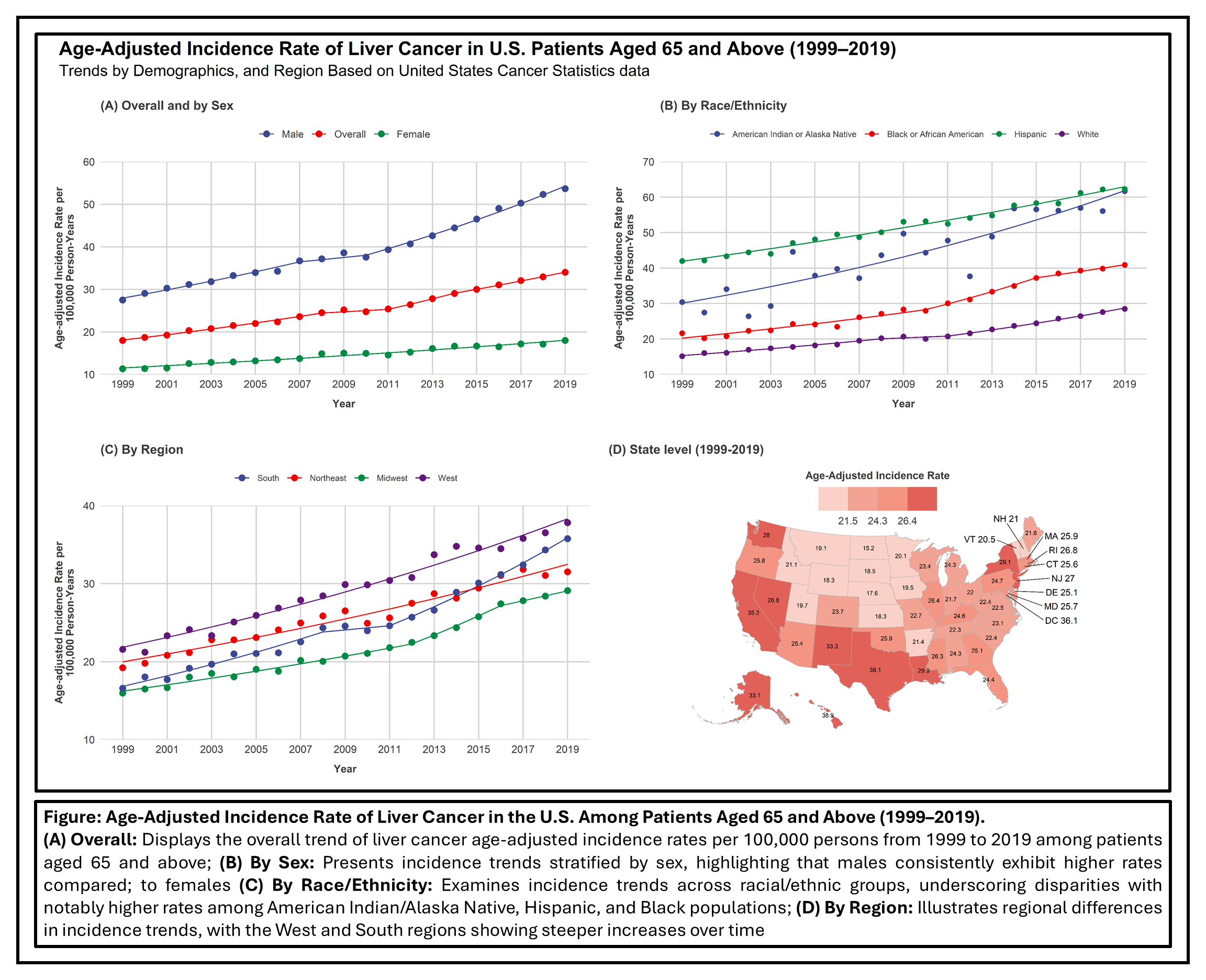Sunday Poster Session
Category: Liver
P1611 - Rising Incidence of Liver Cancer Among Older Adults in the United States (1999-2019): Disparities by Sex, Race/Ethnicity, and Region
Sunday, October 26, 2025
3:30 PM - 7:00 PM PDT
Location: Exhibit Hall

Mohamed B. Elnaggar, MD
Hartford Healthcare
Hartford, CT
Presenting Author(s)
Mohamed A. B. Elnaggar, MD1, Ibrahim Hassan, MBBCh2, Ayah Obeid, MD3, Hatem Eltaly, MD4, Mohamed Abd El Aziz, MD5, Kamran Qureshi, MD6
1Hartford Healthcare, Hartford, CT; 2Faculty of Medicine, Suez Canal University, Ismailia, Al Isma'iliyah, Egypt; 3St. Luke's University Health Network, Bethlehem, PA; 4Cleveland Clinic Foundation, Cleveland, OH; 5Deaconess health system, Henderson, KY; 6Saint Louis University School of Medicine, Saint Louis, MO
Introduction: Liver cancer incidence has been increasing in the United States, particularly among older adults. Understanding demographic and regional variations is crucial for developing targeted interventions and resource allocation strategies. This study examined trends in age-adjusted incidence rates (AAIR) of liver cancer among individuals aged 65 years and older from 1999 to 2019.
Methods: We utilized the United States Cancer Statistics (USCS) Public Use Database (1999–2019) to identify incident liver cancer cases in adults aged ≥65 years. Incidence rates were age-adjusted to the 2000 U.S. standard population and expressed per 100,000 persons. Analyses were stratified by sex, race/ethnicity, and region. Joinpoint regression was used to calculate the Annual Percent Change (APC) for each identified trend segment and the Average Annual Percent Change (AAPC) over the entire study period.
Results: Overall AAIR nearly doubled from 17.99 (95% CI: 17.55–18.45) in 1999 to 34.01 (95% CI: 33.51–34.51) in 2019 (AAPC: 3.21%; 95% CI: 3.13–3.31). During this time, men consistently exhibited higher incidence (27.49 to 53.66) compared to women (11.33 to 17.99), with corresponding AAPCs of 3.38% and 2.26%, respectively.
Among racial/ethnic groups, American Indian/Alaska Native (AI/AN) populations showed the largest relative increase (30.41 to 61.70; AAPC: 3.67%), while Black or African American individuals also had a significant rise (21.62 to 40.88; AAPC: 3.58%). Hispanic populations experienced an increase from 41.99 to 62.29 (AAPC: 2.05%). In contrast, Asian or Pacific Islander groups demonstrated a slight decline in incidence (56.15 to 50.58; AAPC: -0.75%).
Regionally, the West had the highest AAIR in 2019 (37.82), whereas the South exhibited the steepest overall increase (16.59 to 35.76; AAPC: 3.86%). The Northeast (19.21 to 31.51; AAPC: 2.46%) and Midwest (15.97 to 29.10; AAPC: 2.96%) both experienced steady upward trends, underscoring the widespread growth in liver cancer incidence among older adults across all U.S. regions.
Discussion: Liver cancer incidence among U.S. adults aged ≥65 years has continued to rise substantially over the past two decades, with marked disparities by sex, race/ethnicity, and region. These findings highlight the need for tailored prevention, screening, and management strategies, especially in high-risk groups such as AI/AN and Black populations and in regions with rapidly increasing rates.

Figure: Age -Adjusted Incidence Rate of Liver Cancer in U.S. Patients Aged 65 and above (1999-2019)
Disclosures:
Mohamed A. Elnaggar indicated no relevant financial relationships.
Ibrahim Hassan indicated no relevant financial relationships.
Ayah Obeid indicated no relevant financial relationships.
Hatem Eltaly indicated no relevant financial relationships.
Mohamed Abd El Aziz indicated no relevant financial relationships.
Kamran Qureshi: Gilead Sciences – Speakers Bureau. Intercept Pharmaceuticals – Speakers Bureau. Madrigal Pharmaceuticals – Speakers Bureau. Phathom Pharmaceuticals – Speakers Bureau. Salix Pharmaceuticals – Speakers Bureau.
Mohamed A. B. Elnaggar, MD1, Ibrahim Hassan, MBBCh2, Ayah Obeid, MD3, Hatem Eltaly, MD4, Mohamed Abd El Aziz, MD5, Kamran Qureshi, MD6. P1611 - Rising Incidence of Liver Cancer Among Older Adults in the United States (1999-2019): Disparities by Sex, Race/Ethnicity, and Region, ACG 2025 Annual Scientific Meeting Abstracts. Phoenix, AZ: American College of Gastroenterology.
1Hartford Healthcare, Hartford, CT; 2Faculty of Medicine, Suez Canal University, Ismailia, Al Isma'iliyah, Egypt; 3St. Luke's University Health Network, Bethlehem, PA; 4Cleveland Clinic Foundation, Cleveland, OH; 5Deaconess health system, Henderson, KY; 6Saint Louis University School of Medicine, Saint Louis, MO
Introduction: Liver cancer incidence has been increasing in the United States, particularly among older adults. Understanding demographic and regional variations is crucial for developing targeted interventions and resource allocation strategies. This study examined trends in age-adjusted incidence rates (AAIR) of liver cancer among individuals aged 65 years and older from 1999 to 2019.
Methods: We utilized the United States Cancer Statistics (USCS) Public Use Database (1999–2019) to identify incident liver cancer cases in adults aged ≥65 years. Incidence rates were age-adjusted to the 2000 U.S. standard population and expressed per 100,000 persons. Analyses were stratified by sex, race/ethnicity, and region. Joinpoint regression was used to calculate the Annual Percent Change (APC) for each identified trend segment and the Average Annual Percent Change (AAPC) over the entire study period.
Results: Overall AAIR nearly doubled from 17.99 (95% CI: 17.55–18.45) in 1999 to 34.01 (95% CI: 33.51–34.51) in 2019 (AAPC: 3.21%; 95% CI: 3.13–3.31). During this time, men consistently exhibited higher incidence (27.49 to 53.66) compared to women (11.33 to 17.99), with corresponding AAPCs of 3.38% and 2.26%, respectively.
Among racial/ethnic groups, American Indian/Alaska Native (AI/AN) populations showed the largest relative increase (30.41 to 61.70; AAPC: 3.67%), while Black or African American individuals also had a significant rise (21.62 to 40.88; AAPC: 3.58%). Hispanic populations experienced an increase from 41.99 to 62.29 (AAPC: 2.05%). In contrast, Asian or Pacific Islander groups demonstrated a slight decline in incidence (56.15 to 50.58; AAPC: -0.75%).
Regionally, the West had the highest AAIR in 2019 (37.82), whereas the South exhibited the steepest overall increase (16.59 to 35.76; AAPC: 3.86%). The Northeast (19.21 to 31.51; AAPC: 2.46%) and Midwest (15.97 to 29.10; AAPC: 2.96%) both experienced steady upward trends, underscoring the widespread growth in liver cancer incidence among older adults across all U.S. regions.
Discussion: Liver cancer incidence among U.S. adults aged ≥65 years has continued to rise substantially over the past two decades, with marked disparities by sex, race/ethnicity, and region. These findings highlight the need for tailored prevention, screening, and management strategies, especially in high-risk groups such as AI/AN and Black populations and in regions with rapidly increasing rates.

Figure: Age -Adjusted Incidence Rate of Liver Cancer in U.S. Patients Aged 65 and above (1999-2019)
Disclosures:
Mohamed A. Elnaggar indicated no relevant financial relationships.
Ibrahim Hassan indicated no relevant financial relationships.
Ayah Obeid indicated no relevant financial relationships.
Hatem Eltaly indicated no relevant financial relationships.
Mohamed Abd El Aziz indicated no relevant financial relationships.
Kamran Qureshi: Gilead Sciences – Speakers Bureau. Intercept Pharmaceuticals – Speakers Bureau. Madrigal Pharmaceuticals – Speakers Bureau. Phathom Pharmaceuticals – Speakers Bureau. Salix Pharmaceuticals – Speakers Bureau.
Mohamed A. B. Elnaggar, MD1, Ibrahim Hassan, MBBCh2, Ayah Obeid, MD3, Hatem Eltaly, MD4, Mohamed Abd El Aziz, MD5, Kamran Qureshi, MD6. P1611 - Rising Incidence of Liver Cancer Among Older Adults in the United States (1999-2019): Disparities by Sex, Race/Ethnicity, and Region, ACG 2025 Annual Scientific Meeting Abstracts. Phoenix, AZ: American College of Gastroenterology.
